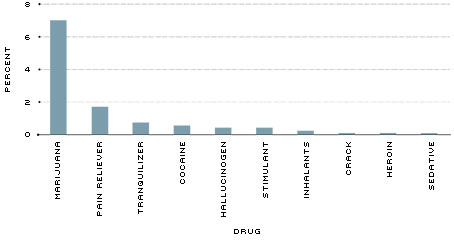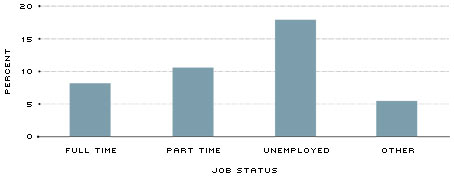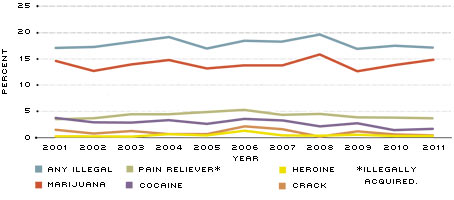Exploring the Link between Drug Use and Job Status in the U.S.
What is the relationship between drug abuse and job status in the United States? This is a complex question involving two directions of causality. Does drug abuse lead someone to become or stay jobless, or does unemployment lead to drug abuse?
On the one hand, drug abuse can reduce a person's employment prospects, both by reducing productivity and by decreasing the chance of getting a job in the first place, especially if an employer tests applicants for illegal drug consumption. On the other hand, those who are unemployed or otherwise out of the labor force may face financial hardship or simply have more unstructured time, either of which can result in a higher propensity to consume these substances, everything else held constant. If so, it would only be natural to think that a national increase in unemployment—such as during the Great Recession—could lead to increased drug abuse and persistent drug addiction issues.
This article provides a quick glance at this relationship, using data about legal and illegal drug use from 2005 to 2011 from the annual National Survey on Drug Use and Health, conducted by the U.S. Department of Health and Human Services.[1]
Caffeine, alcohol and nicotine are by far the most popular addictive substances in the U.S., partly because they are not illegal and partly because their negative health effects are thought to be mild if consumed in moderation. In 2011, 13.5 percent of respondents reported having smoked a cigarette every day during the past month, and 18 percent reported having drunk alcohol more than 100 times in the previous 12 months.
Figure 1 shows the fraction of the population reporting having consumed illegal substances in the month prior to questioning.[2] The figure reveals that marijuana was by far the most popular illegal substance, with 7 percent of the population reporting having consumed it in the previous month. Pain relievers and tranquilizers follow marijuana in popularity and were reportedly consumed by 1.5 and 0.7 percent of the population, respectively. Substances such as crack, heroin and sedatives were consumed by 0.1 percent of the population.
Percent of the Population 12 and Older in 2011 Reporting Consumption of Illegal Drugs in the Previous Month

SOURCE: National Survey on Drug Use and Health 2011.
NOTE: The statistics in this graph refer to consumption of an illegal drug, nonmedical use of drugs available by prescription, or use of an inhalant with a recreational intent. Accidental consumption/inhalation, use of over-the-counter drugs and legitimate use of prescription drugs are excluded.
At first glance, the rates at which traditionally illegal substances are consumed appear inversely related to their addictive potential and to measures of their associated health risks. On the one hand, a medical study on addiction shows that heroin and some stimulants (methamphetamines) are the most addictive drugs, and, as Figure 1 shows, they are used by only a small portion of the population. On the other hand, another study, which focuses on the risk of acute reaction and death, shows that the least hazardous drugs are hallucinogens and marijuana, the latter of which is the most widely consumed, according to Figure 1.[3] These are interesting facts for discussing theories of addiction.
What Is the Long-Run Relationship between Use of Illegal Drugs and Job Status?
The percent of the population 18 and older reporting use of an illegal drug in the previous month averaged 8.2 percent over the sample years 2005 to 2011. Figure 2 shows how this percentage varies with employment status. Illegal drug use was 18 percent for the unemployed, followed by 10 percent for part-time workers, 8 percent for full-time workers and less than 6 percent for those in the "other" category, which includes retirees. The precise definitions of each category are provided in the note under Figure 2.
Percent of the Population 18 and Older, by Employment Status, Reporting Consumption of Any Illegal Substance in the Previous Month (2005-2011)

SOURCE: National Survey on Drug Use and Health 2005-2011.
NOTE: "Full time" includes respondents who usually work 35 or more hours per week and who worked in the past week or had a job despite not working in the past week.
"Part time" includes respondents who usually work fewer than 35 hours per week and who worked in the past week or had a job despite not working in the past week.
"Unemployed" refers to respondents who did not have a job and were looking for work or who were on layoff. For consistency with the Current Population Survey definition of unemployment, respondents who reported that they did not have a job but were looking for work needed to report making specific efforts to find work in the past 30 days, such as sending out resumes or applications, placing ads or answering ads. "Other" includes all other respondents. These could include students, those keeping house or caring for children full time, retirees, the disabled or those with miscellaneous work statuses that were defined as not being in the labor force. Respondents who reported that they did not have a job or were on layoff, but were not looking for work, were classified as not being in the labor force. Similarly, respondents who reported not having a job and looking for work also were classified as not being in the labor force if they did not report making specific efforts to find work in the past 30 days.
Why is drug abuse so strongly related to job status? The simplest potential explanation is that employed drug users "misreport" when they answer the drug-use survey for fear that their confession of drug use would be passed on to their employers. This simple explanation, however, is unlikely for two reasons. First, the survey uses several strategies to reassure respondents of its anonymity. Second, there is a large difference in drug use between part-time and full-time employees—why would one group misreport less than the other? A second possible explanation is that persons with different job status have different amounts of free or unstructured time. A third explanation would say that each of the labor force categories represents different socioeconomic groups, which, for inherent reasons, may have different propensities to abuse these substances.
How Did the Relationship Vary over the Great Recession?
Between January 2008 and January 2010, the U.S. unemployment rate rose from
5 percent to 9.8 percent. The average duration of unemployment increased from
17.5 weeks to 30.4 weeks.[4] Figure 3 displays the share of the unemployed reporting consumption in the previous month for several substances for each year between 2001 and 2011. The Great Recession did not generate a clear temporary or permanent pattern in rates of substance abuse.
Percent of the Unemployed Reporting Use of an Illegal Substance
in the Previous Month

SOURCE: National Survey on Drug Use and Health 2001-2011.
If unemployment had a very moderate impact on drug use, it would be reasonable to expect a sizable decline in drug use among the unemployed during the Great Recession. This follows because the rates of abuse of the newly unemployed should be similar to those of the employed population, which are much lower than those of the existing pool of the unemployed.
However, the rates of drug abuse among unemployed persons did not fall with the switch from employment to unemployment by millions of workers during the Great Recession. We can attribute this behavior to at least three possible factors:
1. Sampling error. The sample used in the survey may not have been representative of the national population of unemployed persons. Under a severe sampling error, it is possible that the survey did not sufficiently cover the "new" group of unemployed people that appeared during the Great Recession. We found some evidence that this hypothesis is at work by observing that the rise in the unemployment rate within the survey sample, although large, is smaller than the national rise during the Great Recession.
2. Composition effects. The majority of people who lost their jobs during the Great Recession may have come from socioeconomic groups that already had a high incidence of drug use.
3. A causal effect of unemployment on drug abuse. A person who moves from employment to unemployment observes an increase in his/her odds of consuming illegal drugs. This causality could be generated, for example, by the urge to appease the financial hardship imposed by unemployment on families, by the increase in spare time that comes with job loss or by increased personal contact with the chronically unemployed.
One interesting consequence of our third factor is that, during episodes of large increases in unemployment, the number of drug users can increase dramatically. Whether these effects are just temporary or have long-lasting consequences will depend on how the relationship between employment status and drug use evolves for an individual user over time.
Endnotes
- The department conducts face-to-face interviews with about 70,000 people every year. [back to text]
- All of our figures were constructed using the online tool at www.icpsr.umich.edu/icpsrweb/SAMHDA/quicktables. [back to text]
- See Gable and Nutt et al. [back to text]
- The unemployment rate and unemployment duration data are publicly available at http://research.stlouisfed.org/fred2/. [back to text]
References
Gable, Robert S. "The Toxicity of Recreational Drugs." American Scientist, 2006, Vol. 94, No. 3, pp. 206-208.
Nutt, David; King, Leslie A.; Saulsbury, William; and Blakemore, Colin. "Development of a Rational Scale to Assess the Harm of Drugs of Potential Misuse." The Lancet, 2007, Vol. 369, No. 9,566, pp. 1,047–53.
Views expressed in Regional Economist are not necessarily those of the St. Louis Fed or Federal Reserve System.
For the latest insights from our economists and other St. Louis Fed experts, visit On the Economy and subscribe.
Email Us

